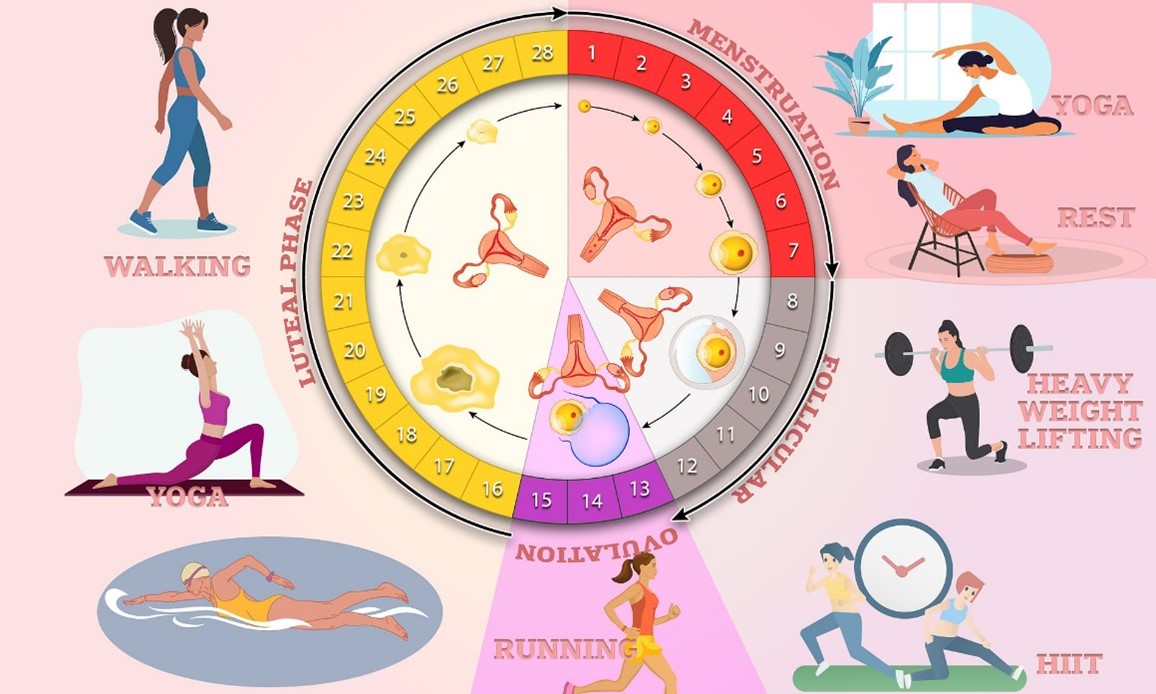Understanding the optimal time to exercise during your menstrual cycle empowers women to maintain their fitness goals while embracing their natural cycle. Hormone fluctuations throughout the cycle are responsible for changes in energy, stamina, and recovery. By adapting workouts to these changes, you will experience more benefits, less pain, and stay healthy.
This is a guide to when and how to exercise during the course of the cycle. It offers guidelines towards energy management, hormone balance, and good workout habits. It is not about being at work with your body and not against it, such that you are in control all month.
Understanding Hormonal Changes and Exercise Impact
To know the optimal windows for exercise, you have to have an understanding of hormone function. Estrogen and progesterone also change each month and have an impact on your mood, how long you are able to keep going, and how strong you feel. The energy is better, and the harder workouts are easier because of the higher estrogen in the follicular phase. In the luteal phase, you may tend to feel tired and bloated; therefore, you may need to do more gentle workouts.
Research indicates that you may work better and have fewer chances of being injured or overtrained if you work out at a level similar to what your body’s hormones require. If these changes are not addressed, they can lead to an increase in the severity and number of cramps, a decreased rate of recovery, and a decreased incentive to continue exercise. Inheriting this link is the first step to creating a long-term, body-friendly workout plan.
Exercise During Menstrual Phase: Rest and Gentle Movement
One question that many women ask during their time of monthly bleeding is whether they can exercise or not. High-intensity training tends to be inappropriate at this time, but light workload training is appropriate. Gentle yoga, flexibility, and short walks are excellent at getting the blood pumping and relieving cramps. They also reduce stress and maintain your mood equilibrium when the energy is low.
Instead of strenuous exercise, do light exercises that benefit your body’s curative opportunities. This makes you relaxed and ready to be more active. Light exercise allows you to feel in control, not that bloated, and maintain a consistent exercise routine without overworking your body at this sensitive time.
Follicular Phase: High Energy and Strength Training Benefits
The follicular phase is typically the optimal time of the month to exercise due to the higher levels of energy that are experienced when estrogen increases. This is the time when cardio, high-intensity interval training, and strength training work well. Since the endurance is improved, the recovery is accelerated, so it’s a good time to build muscle and try endurance.
Women who exercise during this time period tend to make some real progress. Trainers of physical exercises at the moment use hormonal assistance: preparing the bones to face difficult tests. The stage is also one that has good fat-burning quality, so that the combination of foods with exercise proves the best.
Ovulation Phase: Peak Performance Opportunities
The ovulation phase is also the best time for exercise. Estrogen is at its peak; therefore, you may feel more energetic, motivated, and confident. Oxygen is sometimes an advantage here, so this is good for a strength test, fast cardio, or an endurance sport.
But be careful. Even though energy is lacking in the activity, joints may be looser, increasing the injury risk a bit. Listen to your body, warm up well, and maintain good body form. Done correctly, this phase allows you to engage the limits and achieve new fitness goals without endangering your fitness.
Luteal Phase: Adjusting Workouts for Balance
Progesterone rises upon the onset of the luteal phase, and many experience tiredness, mood swings, or bloatedness in the body. It may not be the best time to exercise, but it doesn’t mean you should stop. Instead, though, very light forms of activity like Pilates, deep muscle and bone training, or slightly intense strength-training sessions will allow keeping the balance without being overly effective.
Adding in some calm practices, such as yoga or meditation, can reduce stress and help to deal with premenstrual symptoms. This is an important period to stick to it and not overdo it at work. Listening to your body enables you to maintain a budget of fitness, minimize discomfort, and be vibrant with hormone health.
Long-Term Benefits of Cycle-Synced Exercise
Training according to your cycle makes sense not only from the perspective of your comfort right now; it has long-term effects on you. When regular exercise is included in accordance with the cycle, the likelihoods of experiencing cramps, moodiness, or having imbalanced hormones are reduced. It also aids in sleep, improves metabolism, and maintains energy throughout the month.
Also, coordinating exercise with natural shifts in hormones prevents excessive exercising and creates a routine. Over time, this can help you to remain fit, strong, and emotionally as well as physically healthy. It makes exercise not only a hard task to do every day but a journey to love for your body.

